“Look, here are the labyrinths!”, calls out the First Mate. “Over here.”
We are on the island of Kluntana in the Luleä archipelago, and following a trail marked out on a map. Earlier in the day, we had sailed out from Luleä, and tied up to the small pontoon in the westward facing bay. A church group on an outing are already there, and were singing hymns on the beach as we tied up. Quite a welcome. Shortly afterwards, the ferry had arrived and the congregation had shuffled on board, their day trip to the island over.

The labyrinths are circular whorls of stones built by fishermen. No one quite knows whether it was to while away the time when they couldn’t go fishing, or whether it was to bring good luck when they could. I prefer the latter. Surely there would be a lot more labyrinths if they were just passing the time of day.

“And I can see the lookout tower in the distance”, I say. “It must have given a good view out over the sea.”
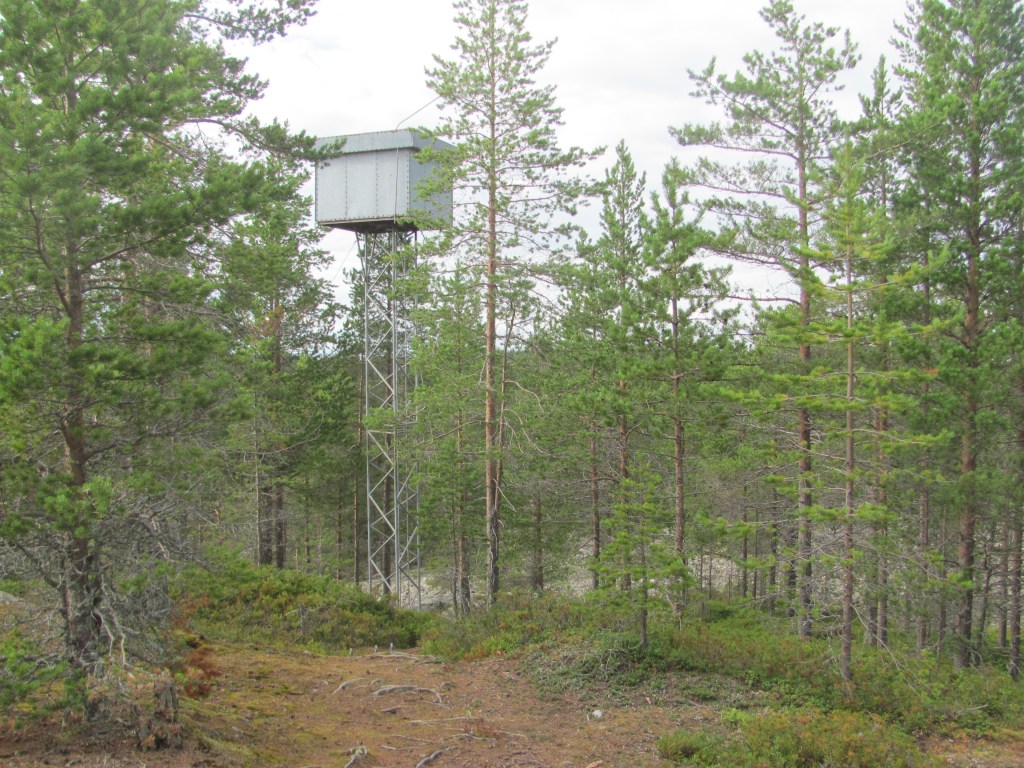
“And here’s the rock that looks like the face of an old man”, calls the First Mate.

“Now that we are so close”, I say over dinner in the evening, “we have to get to Törehamn. It’s the northernmost part of the Baltic that you can sail to. There’s a buoy there that marks it, and apparently you can get a certificate.”
“Let’s do it”, says the First Mate. “It’s what we came for, after all.”
It’s about 30 miles to Törehamn. We set off from Kluntarna early. It’s a gorgeous day, but there’s not much wind, so progress is sedate. On the AIS, we can see Saluté also heading there. They are a little closer than us, having been on another island for a few days.

“It’s beautiful up here”, says the First Mate dreamily. “And we have it all to ourselves, more or less. I am surprised that we haven’t seen more boats.”
“It’s such a long way up here”, I say. “That deters a lot of people. It takes at least two weeks to get up here from Stockholm, and at least two weeks to get back, so it doesn’t leave much time to explore. It’s only retirees like ourselves who can afford the time.”
The wind picks up, and we sail the last few miles at a good speed. In the distance we can see the grain silos marking the harbour at Törehamn. Saluté is already there, tied to the buoy.
“We made it!”, shouts Catherine. “You take our photo, and we’ll take yours. Then we can go and collect our certificates from the café.”
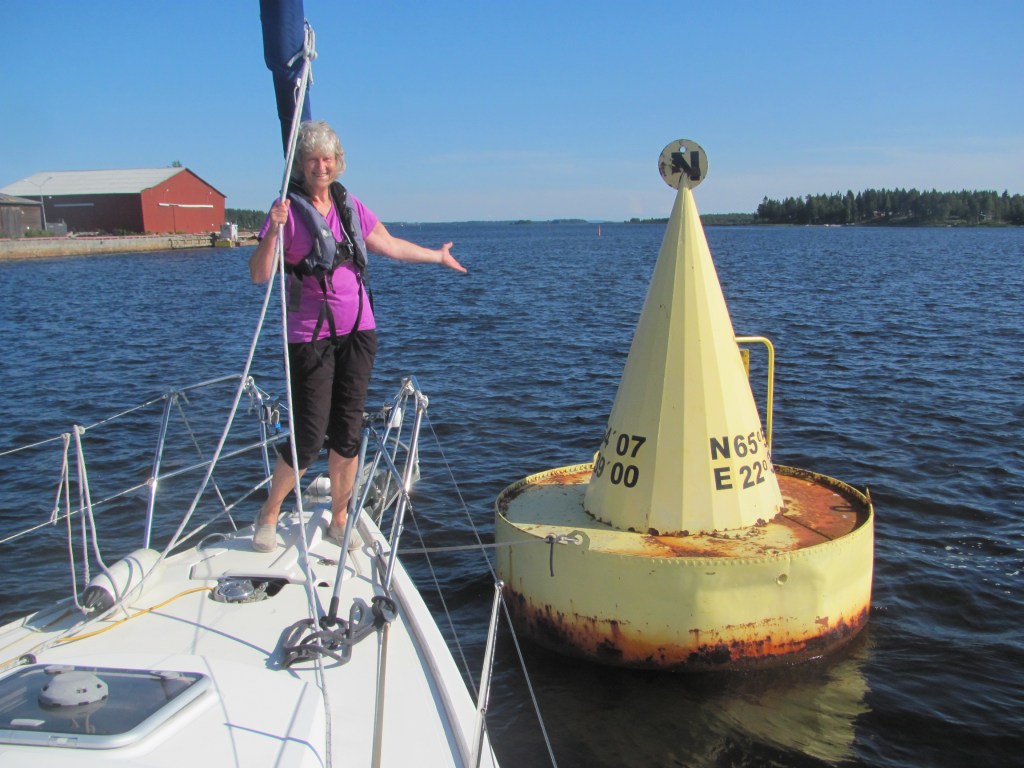
“It’s a strange feeling”, says the First Mate, over an ice-cream. “For the last few weeks, we have been working towards getting here. Now we are here, it feels a bit of an anti-climax. From now on, we are heading south again. It’s a pity we don’t have time to explore a bit more up here. It’s so beautiful.”
“We still have all the Finnish side to explore on the way back”, says Gavin. “That should keep us busy.”
Törehamn is rather industrial and not very picturesque, so we decide to head back to Gärdsviken for the night, a small harbour we had passed on the way up. We receive a warm welcome from the harbourmaster.

“We belong to the Törehamn Sailing Club”, he explains. “I am the club chairman, and this is our summer harbour. We are always pleased to welcome visiting sailors. Especially British ones, as we don’t see many of them up here. You two boats are the first ones this year.”

“We love coming here and getting away from it all”, another member says. “We don’t have any power, and all the water is collected from rainwater. But we have plenty of wood, so the sauna is woodfired and we have lots of barbecues. And there are lots of nice walks. There are even elk in the forest – some people go hunting for them.”
In the evening, we decide to take a sauna. We strike up a conversation with a club member who is a ‘techie’ working in the energy business.
“We’ve been working on projects to make steel production more sustainable”, he tells us. “We are looking at hydrogen from the ionisation of water as a way of heating the furnaces rather than coal.”
“But hydrogen is not really a source of energy, just a carrier”, I say. “You need lots of energy to ionise the water, and if that energy is from fossil fuels, you just end up shifting the emissions from one place to another, not reducing them.”
“True”, he says. “But we are looking at renewable sources of energy for that. Solar of course, but we also have lots of hydropower in the north of Sweden. Consequently, our electricity costs are substantially lower up here than down south. So much so, Facebook have even located their data servers in Luleä to cut costs.”
It’s getting hot. We take a breather and go and jump into the sea.
“What about the Sámi people up here?”, I ask him when we return. “Are there tensions between them and the mining and energy companies?”
“For sure there are”, he responds. “They want to keep the land for their reindeer herds and traditional way of life. But they are only a small fraction of the national economy. There are vast energy sources and mineral wealth up here that the country needs. You can’t stand in the way of progress.”
It’s a dilemma. Western civilisation needs energy and minerals to function. And yet, our extraction of them is destroying the ancient cultures of indigenous people worldwide, and our use of them is harming the planet by releasing greenhouse gases and pollutants into the environment. All in the name of progress. In this little club harbour with its reliance on natural energy and water, I wonder to myself if another way of life is possible?

“It’s ironic that all these folk are only able to enjoy the ‘get back to nature’ and simplistic lifestyle because they have boats to get here and well-paid jobs in the cities to buy the boats”, sniffs Spencer later.
“I think you are being a little bit unfair”, I say. “At least there is a desire to get back to nature. If that could be encouraged more widely it might be possible to live more sustainably.”
“Well, you are welcome to try”, he retorts. “I think you will find it is very difficult to scale up that way of thinking to the global population.”
Our plan is to get to Haparanda, the last town in Sweden before crossing into Finland. The club chairman advises us that the harbour at Haparandahamn is too shallow for our draft, so we are better to moor at Seskarö island and to catch the bus into Haparanda.
The next morning, we sail from Gärdsviken to Seskarö island. The wind has gone round to the south, and we enjoy a pleasant beam reach most of the way. At one stage a helicopter passes overhead with some kind of hopper suspended below it. We learn later that it is carrying fertiliser, but no one quite knows where to or what for. Farms or forest?

Eventually we reach Seskarö, and tie up to the small wharf.
“Let’s have a glass of wine and relax”, says the First Mate..
Somehow I manage to tip my drink over the laptop keyboard.
“Quick, turn it upside down”, says the First Mate. “It’ll stop it from going inside and help it drain.”
It helps, but it is too late. Before long, the keys start to feel sticky and to type long repetitive sequences of letters when I press them. But at least the computer itself seems to be still working.
“%%^^^****!!!!&&&”, I say. “It’s a disaster. I depend on the computer so much for everything – route planning, keeping the diary, writing the blog, watching the news. What will I do now?”
“Take it with us when we go into Haparanda tomorrow”, says the First Mate. “We might find someone who can fix it.”
We catch the bus into Haparanda in the morning. It is an interesting town. Originally there was only one town there, called Tornio, on the banks of the Torne River. Then, as a result of the Russian-Swedish War of 1809, Finland, which was Swedish territory at that stage, was ceded to Russia. It was decided to make the border between the two countries along the river, meaning that Tornio came to be in Finland. The Swedes nevertheless decided that they also needed a border town, so built Haparanda on the other side of the river. Nowadays, the two towns together are designated as a ‘Eurotown’, administered separately, but for all intents and purposes, operating as one.
“We mustn’t forget that Finland is one hour ahead of Sweden”, says the First Mate. “We don’t want to miss the bus by an hour. It’s the last bus until the morning.”
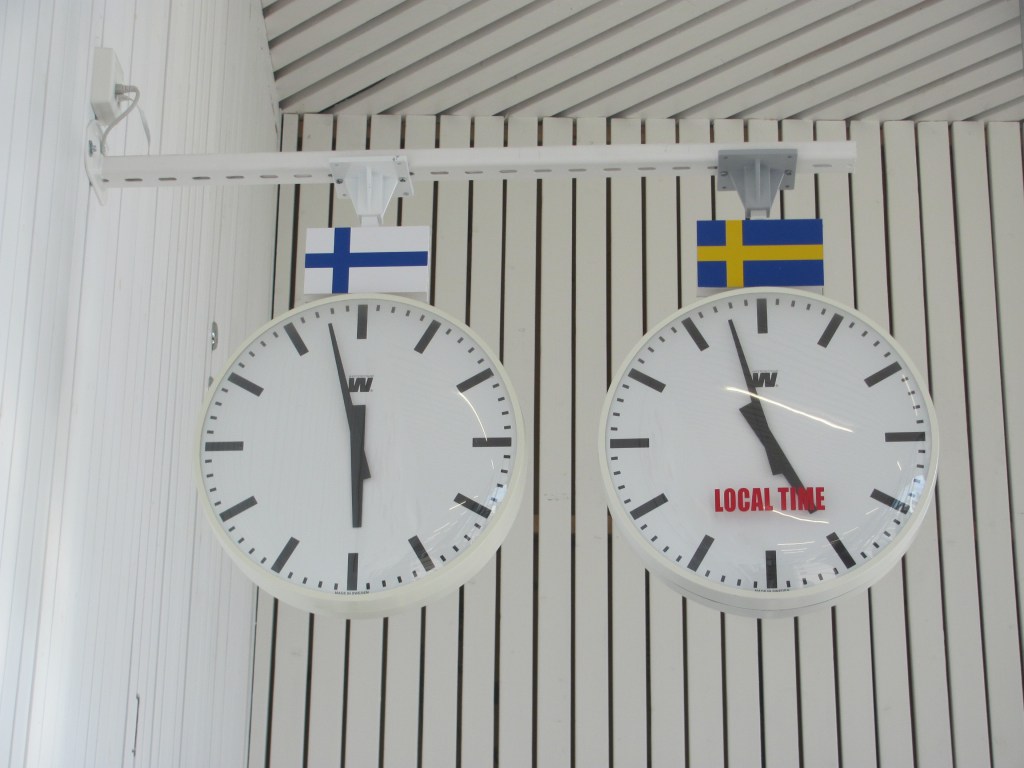
I find a computer repair shop in Tornio. The man sucks in his breath.
“I could fix it”, he says. “But I would have to order a new keyboard. And it has to be the UK version, and we only have Scandinavian ones here. It could take a week. When do you need it by?”
“This afternoon?”, I say hopefully.
“No chance”, he says. “But I tell you what. I could give you an external keyboard to plug in, and you could use that. It won’t be elegant, but at least it would work.”
“It sounds like a good solution”, says the First Mate. “Take it. Now let’s get lunch. I’m famished.”
We find a small café and order the soup.
“It’s funny having to pay in Euros on this side of the river and kroner on that side”, says the First Mate. “And two different time zones. And everything is in Finnish. What a language. Look at this newspaper. I can’t understand a thing. All those double letters everywhere. It’s almost as if someone’s keyboard has stuck.”
“That was a bit below the belt”, I groan.

“With Swedish at least, you could kind of work out what it meant because of the similarities with German”, says the First Mate. “Swedish has evolved from the northern German languages, after all. But with Finnish, I don’t know where to start. It’s totally different.”
“Finnish is not an Indo-European language, but instead is a Uralic language because its centre of origin is thought to be the Ural Mountains where the Volga River bends to the west”, Mr Google tells us. “It is related to Hungarian and Estonian. When Finland was ruled by Sweden, the Finnish language was considered inferior – the administrative language was Swedish, and Finnish was only allowed to be spoken and not written.”
“Fascinating”, says the First Mate. “No wonder we can’t understand it. Anyway, let’s pay and go and explore.”
The only thing of note in Tornio is the old wooden Eastern Orthodox church. Unfortunately it is locked.

We cross back over the bridge into Haparanda.
“Look, this is where the border is”, says the First Mate. I can stand with one leg in Finland and the other in Sweden. How cool is that?”
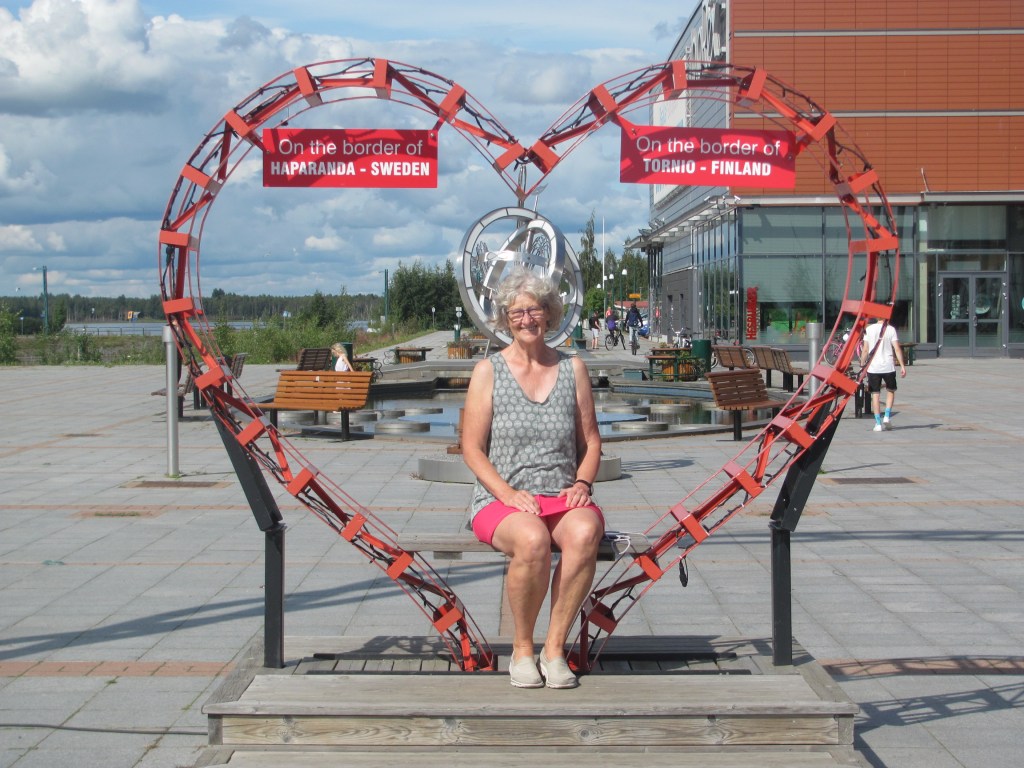
The church in Haparanda is ‘uncompromisingly modern’, the guide book tells us. A must see. It is interesting, to say the least. It reminds me of a warehouse. But I have seen worse.
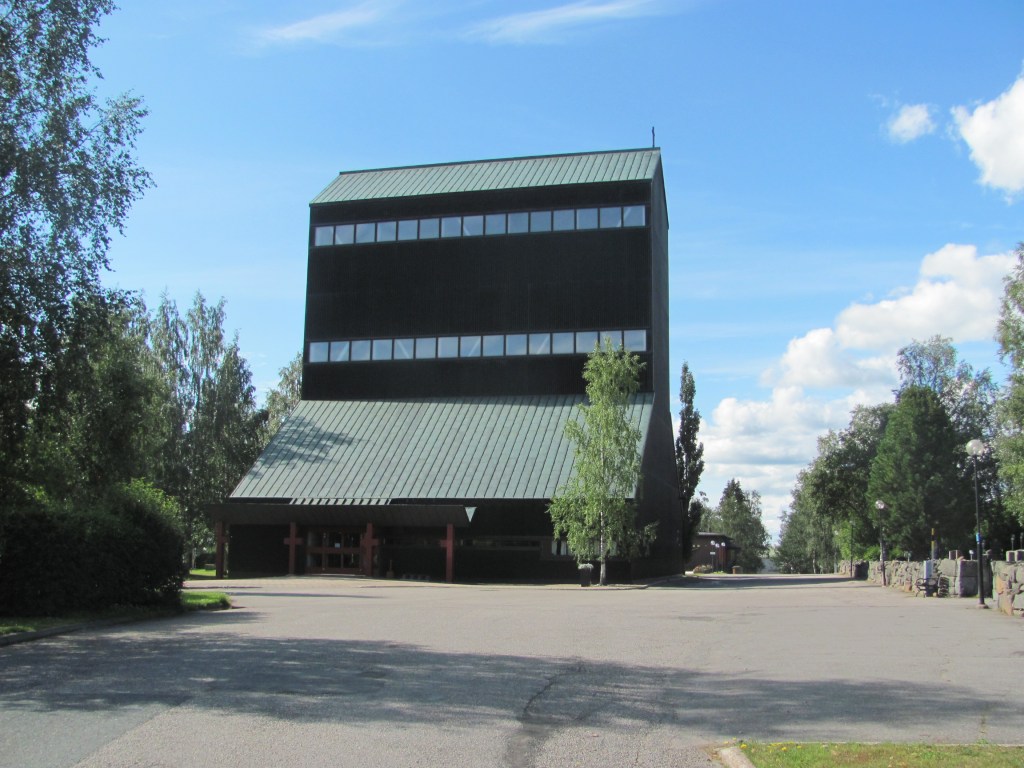
Inside it looks a bit more like a church.

“Look, there is the IKEA store over there”, exclaims the First Mate, pointing to a blue and yellow building as we walk back. “Apparently it is the northernmost IKEA store in the world. Why don’t we have a look around it and have an early dinner before we catch the bus back? I haven’t had meatballs for a while.”
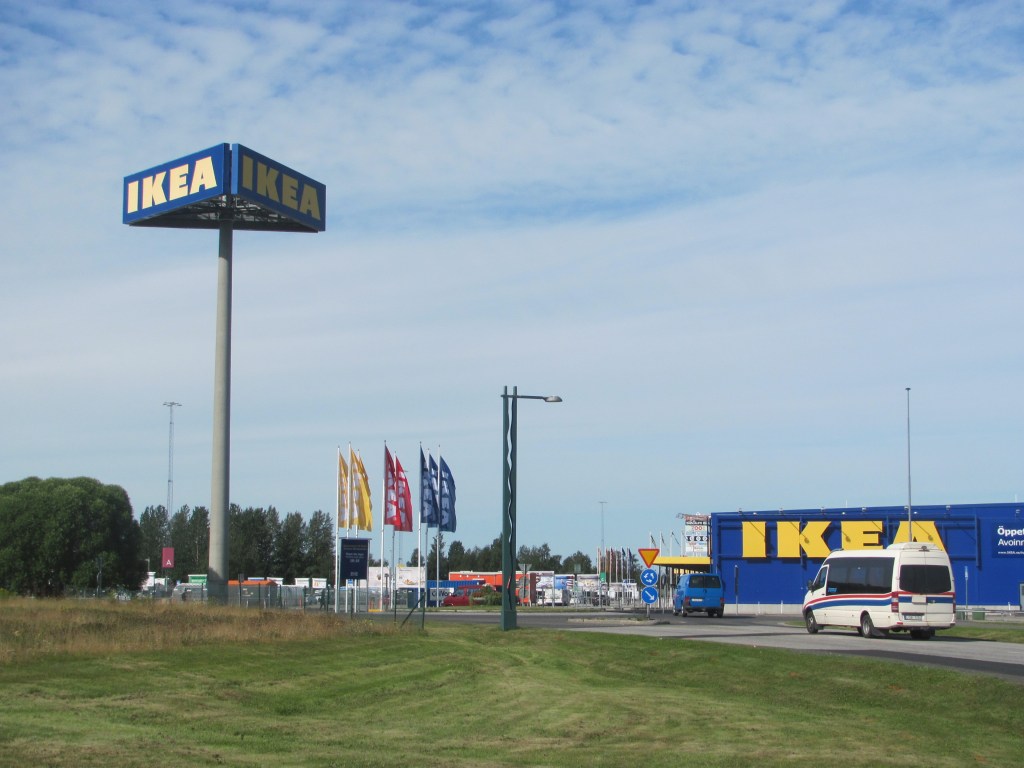
Most of Haparanda seems to have had the same idea. The queue is long. Eventually we make it though, and scoff our meatballs down before dashing for the bus station.
“I thought you said that the bus leaves at 1700?”, the First Mate says accusingly, as we arrive breathlessly. “The timetable says 1710. I could have enjoyed my dinner more instead of rushing and getting indigestion.”
“I made a mistake”, I say. “Sorry. It hasn’t been my day.”
In the evening, I try my new keyboard. It works, but is a bit cumbersome.
“At least you can still keep doing the blog”, says the First Mate.

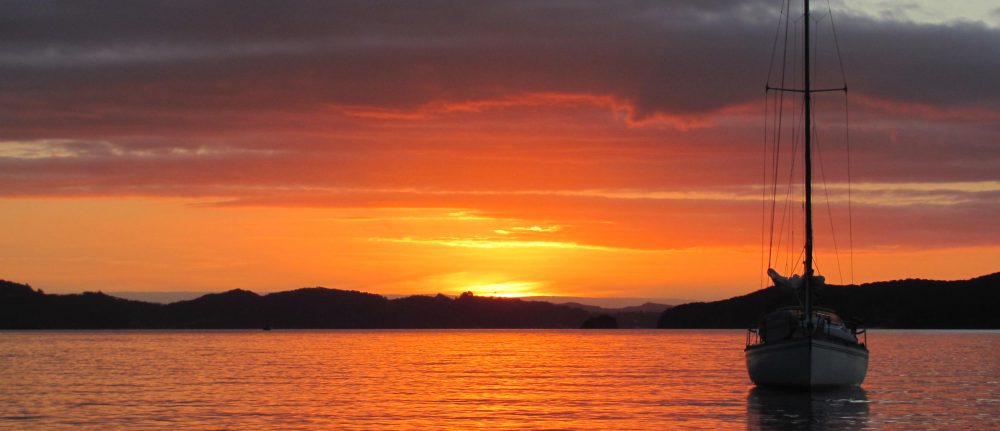
Massive Well Done to you both for your epic travels!
LikeLike
Thanks, Birgitta. Yes, we have enjoyed it all so far, and the Lulea archipelago is a beautiful part of the country. Hard to imagine it will all be ice soon!
LikeLike